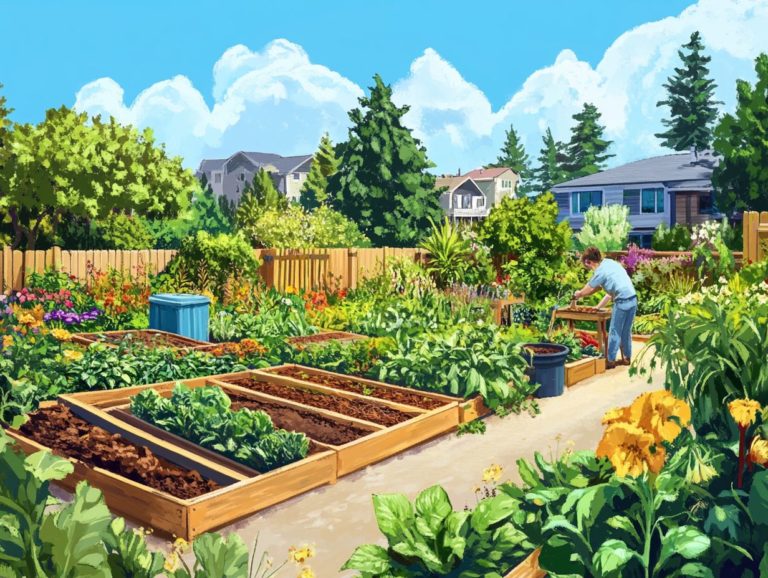What is the Role of Urban Permaculture in Cities?
Urban permaculture is reshaping your relationship with the city. Discover sustainable solutions that integrate ecology and community like never before!
This article delves into the essence of urban permaculture. It outlines its fundamental principles and the numerous benefits it offers for both the environment and society.
You ll discover effective strategies for incorporating permaculture into urban landscapes. You will confront typical challenges and explore inspiring case studies that showcase successful initiatives.
Engage with us as we reveal how urban permaculture plays a vital role in cultivating resilient, flourishing communities.
Contents
- Key Takeaways:
- Understanding Urban Permaculture
- Benefits of Urban Permaculture
- Implementing Urban Permaculture
- Challenges and Solutions
- Examples of Successful Urban Permaculture Projects
- Frequently Asked Questions
- What is the Role of Urban Permaculture in Cities?
- How does Urban Permaculture benefit cities and its residents?
- Can Urban Permaculture be implemented in any city?
- What are some examples of Urban Permaculture in action?
- How can individuals get involved in Urban Permaculture?
- Is Urban Permaculture only focused on food production?
Key Takeaways:

- Urban permaculture is a design approach that integrates sustainable practices into city living, promoting environmental and social benefits.
- By implementing strategies such as rooftop gardens and rainwater harvesting, urban permaculture can improve air quality, reduce food waste, and build community resilience while enhancing food security.
- Overcoming challenges such as limited space and accessibility in urban settings requires creative solutions, as seen in successful projects like community gardens and green roofs.
Understanding Urban Permaculture
Urban permaculture is a thoughtful design approach that integrates sustainable agricultural methods into urban environments. It draws inspiration from pioneers like Bill Mollison, David Holmgren, and Laura Marie Neubert.
This approach builds strong urban ecosystems that thrive together. These systems are crafted to flourish in the face of contemporary challenges like climate change, drought, and food security, ensuring that urban living can harmoniously coexist with nature.
Definition and Principles
The core principles of urban permaculture guide you in designing sustainable systems that emulate natural ecosystems while fostering ecological awareness and community engagement.
By embracing diversity, these systems bring together a variety of plants and animals that work in harmony. This provides protection against pests and diseases, ultimately enhancing resilience. Take, for instance, a community garden that utilizes companion planting growing different plants together to help each other grow better. Herbs like basil thrive alongside tomatoes, boosting growth and flavor while keeping pesky invaders at bay.
The concept of synergy highlights the interconnectedness of urban elements, allowing for more efficient resource utilization. Imagine pairing rainwater harvesting systems with vertical gardens to maximize water conservation.
Ultimately, these foundational principles advocate for an urban environment that not only fulfills human needs but also nurtures the surrounding ecosystem through innovative agricultural practices.
Benefits of Urban Permaculture
Urban permaculture presents a wealth of advantages for you to consider. It enhances food security, ensuring that fresh produce is readily available. It also strengthens community ties by establishing community gardens, creating spaces for connection and collaboration.
It also promotes better climate resilience by nurturing biodiversity within urban environments through sustainable practices, helping to create a more sustainable future.
Ready to get involved? Explore local urban permaculture projects and be part of the change!
Environmental and Social Advantages

The environmental and social benefits of urban permaculture are truly remarkable. They contribute not just to sustainable urban living but also to the enhancement of urban ecosystems.
By embracing this approach, you can dramatically enhance air quality today by creating green spaces that serve as natural air filters, effectively reducing pollutants. Urban permaculture promotes biodiversity by establishing habitats for a variety of species, from pollinators to birds, enriching the urban landscape.
On a social level, as communities engage in these initiatives, you ll notice a blossoming sense of belonging and shared purpose. This fosters stronger community ties. Educational opportunities abound as individuals learn about sustainable practices and healthy food production, empowering them to make informed choices.
By integrating these elements, urban permaculture offers a complete solution to today’s challenges, beautifully illustrating the interconnectedness of environmental stewardship, agroecology, and social well-being.
Implementing Urban Permaculture
Implementing urban permaculture invites you to explore a range of innovative strategies and techniques. These creatively leverage your available space. Consider establishing vertical farms and rooftop gardens to maximize the potential of urban environments.
By doing so, you not only enhance your surroundings but also contribute to a more sustainable future.
Strategies and Techniques
Incorporating smart farming and practices that restore soil health can elevate the effectiveness of your urban permaculture projects. The study of food culture enriches your understanding of the cultural dimensions of food systems.
By integrating smart sensor networks into your farming practices, you can achieve real-time monitoring of environmental conditions. This empowers you to make informed decisions that align with ecological sustainability.
A solid grasp of soil biology allows you to enhance nutrient cycling and boost crop resilience. This fosters a holistic approach to urban agriculture.
By weaving together these disciplines, your urban permaculture efforts will flourish. They will nurture stronger connections between people and the food they consume, ultimately paving the way for a more sustainable future.
Challenges and Solutions
Despite the numerous advantages that urban permaculture offers, you will encounter challenges. These include environmental issues like drought and the management of organic waste. These obstacles demand innovative solutions to ensure the success and sustainability of your efforts.
Overcoming Obstacles in Urban Settings

Overcoming obstacles in urban environments requires your active engagement with the community. It also entails adopting sustainable practices tailored to address specific local challenges, such as climate change.
One primary challenge you might face in urban permaculture projects is limited space, which can significantly impede traditional farming methods. To counter this, many communities have turned to vertical gardening techniques. This allows you to cultivate food even in the tightest of areas. Utilizing rooftops for gardening not only maximizes the urban space but also contributes to reducing the urban heat island effect.
By engaging local residents through workshops, you can foster a sense of ownership and raise awareness about sustainable practices. Collaborating with local governments can enhance your access to resources, funding, or land for community gardens. This transforms obstacles into opportunities for collective growth and resilience.
Join the movement! Start your urban garden today and be part of the change!
Examples of Successful Urban Permaculture Projects
Discover successful urban permaculture projects around the globe. Notable examples come from the Urban Permaculture Laboratory, the World Permaculture Association, and initiatives discussed at the FAO symposium.
These projects showcase innovative practices in diverse regions, such as southern Italy, emphasizing traditional farming techniques. They highlight the potential for sustainable living in urban settings.
Inspiring Case Studies
Inspiring case studies featuring vertical farms and community gardens reveal the remarkable potential of urban permaculture in sustainable urban ecosystems.
These examples showcase innovative agricultural techniques and highlight the vibrant sense of community that blossoms when individuals unite to cultivate shared spaces. By embracing methodologies that prioritize biodiversity and resource efficiency, you can enjoy the benefits of fresh produce while minimizing food miles.
The results from these initiatives often transcend simple food production. They create educational opportunities and deepen your connection to nature. The positive effects on local economies and public health emphasize the critical need to weave permaculture principles into urban planning and community development strategies.
Frequently Asked Questions
What is the Role of Urban Permaculture in Cities?

Urban permaculture is vital for creating lively, sustainable cities! It involves designing regenerative systems that mimic natural ecosystems to provide food, water, and energy in urban areas.
How does Urban Permaculture benefit cities and its residents?
Urban permaculture has numerous benefits:
- Increases access to fresh, locally grown produce
- Improves air and water quality
- Promotes community engagement
- Reduces the carbon footprint of cities
Can Urban Permaculture be implemented in any city?
Yes! Urban permaculture principles can be applied in any city, regardless of size or location. The key is to adapt the design and techniques to the specific needs and conditions of the city.
What are some examples of Urban Permaculture in action?
Successful examples of urban permaculture projects include:
- Community gardens
- Rooftop gardens
- Vertical farms
- Green roofs
- Urban farms
- Rainwater harvesting systems
These projects positively impact cities worldwide by enhancing biodiversity and promoting climate resilience.
How can individuals get involved in Urban Permaculture?
Individuals can participate in urban permaculture by:
- Volunteering at local community gardens
- Participating in workshops and classes
- Implementing permaculture principles in their homes and neighborhoods
Engaging with experts like Bill Mollison and David Holmgren can also deepen your understanding of these concepts.
Is Urban Permaculture only focused on food production?
No! While food production is significant, urban permaculture also includes sustainable practices like:
- Water conservation
- Renewable energy
- Waste management
- Ecological building design
This holistic approach contributes to the overall health of urban ecosystems.
If you re interested in urban permaculture, explore local initiatives or resources in your community!






